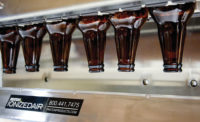Lowering overall energy consumption of retort operations and consuming less water in the preparation of shelf-stable food are not only sound financial strategies but also methods to improve the long-term sustainability of the plant. A proven way of accomplishing savings in energy and water is by applying heat and water capture and reuse systems. With these state-of-the-art systems, water usage can be reduced in the retort room by as much as 50%, and energy savings on an annual basis can, for large operations, exceed $150,000 for electricity and $50,000 in natural gas costs.
The Energy- and Water-Intensive Shelf-Stable Food Process
Every day, packaging lines heat thousands of gallons of water to generate steam or super-heated water for the sterilization process of shelf-stable food packaged in cans, jars, trays and pouches. After the low acid food has been sterilized, the water is typically flushed into the sewer system or steam is vented into the atmosphere — losing the energy value initially put into the water. Also, for sterilization processes, cold water is used to reduce temperature within the vessel to complete sterilization and equalize pressure within the package. This water is also simply flushed away in many operations.
Capture and Reuse Systems
To conserve both heat energy and water, a way to capture and reuse both is needed. Captured heat energy in the form of hot water can be reused for heating the plant, clean-in-place, washdown and/or provide heat for food processing. One of the most efficient uses for captured energy and water from the retort process is to preheat boiler-feed water via a heat exchanger. By heating ambient temperature water flowing into a steam generation boiler, less energy from natural gas or electricity is required to make steam or super heat water. The key pieces equipment in this capture and reuse system are:
- Heat exchangers
- Storage tanks
- Associated hardware, including pumps, variable frequency drives, automated valves and piping
- Control architecture
The heat exchangers transfer the heat energy from one system to the next. Storage tanks serve as hot and cold reservoirs to retain heat energy and water for subsequent usage. Pumps move the fluid to where it is needed. The control architecture is the brains of the system and also a sustainability recorder, documenting the savings and providing valuable data. Capture and reuse can be applied to nearly every step of the process cycle, during heating or cooling. The choice of which part of the process to utilize for capture and reuse is best made in collaboration with the retort system supplier. That supplier’s expertise will be invaluable in a number of different ways.
It is vital to note there are limiting factors to the heat-exchange/recapture strategy. The amount of hot water that can actually be used per day is one of them. It does not make financial sense to recapture heated water that cannot be reused. Heat capture and reuse systems require space for storage tanks, pumps and piping. Some plants simply do not have the existing floorspace available.
Most importantly, the capture and reuse system must not affect FDA approved processes. For example, in saturated steam retorts, the come-up-vent-open step requires that any system capturing the heat contained in the steam must not create back pressure. The design of capture and reuse systems requires engagement of a supplier with expertise in retort technology and thoroughly schooled in FDA requirements.
How Much Money Can Be Saved In the Retort Room From Capture and Reuse?
An Allpax customer installed a capture and reuse system in its large, multi-vessel retort room used for sterilizing canned foods. Plant operations personnel estimate that the steam-capture-and-reuse system for its saturated steam retorts creates up to 70 gal per minute of flash-condensed 180°F hot water during the come-up-vent-open cycle. Total duration time for capturing steam is 480 minutes per day.
This means that the plant captures and reuses 33,600 gal of 180°F water per day. Based on a U.S. average price of $6.23 for 1,000 cubic feet of natural gas (MCF), $.0638 per kilowatt hour (KWH), and an average 57°F ambient temperature of water entering the plant, the daily and annual savings of capture and reuse can be estimated as show in Figure 1. (See sidebar for formulas used.)
Figure 1: Energy Saved
|
|
KWH |
MCF |
|
Day |
$632* |
$209 |
|
Year** |
$164,000 |
$54,000 |
*Savings rounded for simplicity
** 260-day work year used in the calculations
In the example above, the savings per 1,000 gallons put through capture and reuse are shown in Figure 2.
Figure 2: Savings for every 1,000 gallons captured
|
|
KWH |
MCF |
|
Day |
$19 |
$6.20 |
|
Year |
$4,940 |
$1,612 |
While the cost of gas and electricity vary and the ambient water temperature entering the plant will also be different in various regions, the 1,000-gal savings figures in Figure 2 can provide operations personnel with a ballpark estimate of what a plant may expect from one of these systems.
Lowering the Carbon Footprint of the Plant
Not only do plants with capture and reuse save money, they also lower their carbon footprint. Figure 3 shows just how much the plant capturing 33,600 gal per day contributed to a more sustainable future by offsetting CO2 emissions compared to equivalent burning of coal or gasoline. The numbers demonstrate how much less energy is consumed by natural gas. The equivalencies come from the online EPA Greenhouse Gas Calculator.
Figure 3: Lower CO2 Emissions Equivalencies
|
Lowered CO2 emissions comparable to
|
KWH equivalent |
MCF equivalent |
|
Gallons of gasoline consumed
|
204,785 |
53,936 |
|
Pounds of coal burned |
2,005,303 |
528,152 |
In the sustainability movement, experts talk about the triple bottom line: the economic benefits to the organization, social benefits to the areas in which the organization operates, and the environmental benefits generated by the organization. The more sustainably an organization operates, the higher those three components rise. Capture and reuse in the retort room offers triple bottom-line benefits and is a technology available and affordable today.
|
Calculate BTUs Saved
Calculate the Savings in Natural Gas
Multiply total daily savings by number of workdays in the year for an annual estimated savings by capture and reuse.
Calculate Savings in Electricity
Multiply total cost by workdays in a year to determine annual savings.
Why Include Ambient Water Temperature in the Equations?The colder the ambient water entering the plant the higher the savings because the heat energy measured in BTUs serves to offset the higher cost of heating colder water. The warmer the water coming into the plant, the fewer BTUs will be saved. This means the return on investment in a capture and reuse system will be incrementally less.
There Are No Perpetual Motion MachinesThere is a percentage of heat loss — BTUs lost — in every system. This means that in the examples there would have been some percentage fewer BTUs saved. The top liquid-to-liquid heat exchangers may reach 95 percent efficiency in heat transfer, which means 5 percent of the energy is lost in the heat exchange process. During an energy savings audit, the auditors will factor heat loss into the overall calculations of energy savings.
Every System Will Offer Its Own Unique SavingsDepending on the type of retort, size, type and number of containers, and cycles per day, the savings for a plant will be unique to the situation. The formulas in this article provide ballpark estimates. For an estimate based on a plant’s setup, Allpax will enter particulars into a custom calculator. Write to allpax@promachbuilt.com and indicate interest in Batch Retort Analysis Tool energy and water saving estimates. |



